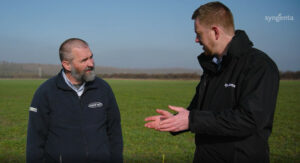NIAB research helps growers prioritise grass weed control
13th March 2023
NIAB research has highlighted the immediate priority for growers to target grass weeds already in the crop now, rather than waiting for more to emerge later in the spring. The results reinforce the role of Axial Pro for early grass weed control.

Pete Hawkins (right) & John Cussans (left)
John Cussans, weed biology and management specialist at NIAB reports the trials, in association with Syngenta, will help growers focus on what weeds they want to control, both from a crop competition point of view, but more importantly from the potential seed return.
“The message for early spring is the weeds you see in the crop right now are the ones that you are targeting; the ones that germinate later and later are less and less of a threat to the crop, and less and less of a threat in terms of ongoing seed return,” he advised.
“For growers there’s naturally a tendency to think I’ve got this weed that germinates through the season, I’ll wait until every last individual has emerged to target my application timing.
“In fact, we can now see quantitively that you would be better off focussing on rates and timings that get good control of those early germinating weeds, accepting that the smaller number of later germinating weeds may well come into the field. But overall your strategy should be to get that maximum efficacy on early emerging weeds.”
Syngenta field technical manager, Pete Hawkins, advised the advice from the trial for Axial Pro application this season is to target ryegrass and wild oats when they are smaller and actively growing.
“Prioritise fields with larger overwintered weeds and ideally control weeds before fertiliser applications, that will further strengthen their growth.
“Also consider tank mixing with PGRS and appropriate broad-leaved herbicides to save time and make effective use of application windows,” he added.
“And finally optimise application techniques to ensure good coverage of weeds and achieve best possible control.”
John Cussans added: “We need to remember that there is a whole load of grass weeds to manage in the future; not just to focus on black-grass.
“That means we need to look at different aspects of weed biology. Some of these other grass weeds, like wild oats and bromes, have different biological characteristics than black-grass.
“We are repeating the trial this year, where we have added an element of application timing and rates to really complete the whole picture to help growers target these weeds much better.”
Click here to watch a video report of the NIAB grass weed guidance.
